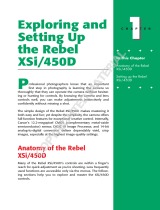ENG-9
Tips on Using the Image Stabilizer
• The Image Stabilizer cannot compensate for a
blurred shot caused by a subject that moved.
•
Set the STABILIZER switch to when you are
taking pictures using the Bulb setting (long
exposures). If the STABILIZER switch is set to ,
the image stabilizer function may introduce errors.
• The Image Stabilizer might not be fully effective
in the following cases:
•You shoot while riding on a bumpy road.
•You move the camera dramatically for a
panning shot in Mode 1.
•You shoot using techniques other than
following shots in Mode 2.
• The Image Stabilizer consumes more power
than normal shooting, so fewer shots can be
taken if you use the function.
•
The image stabilizer operates for about two
seconds even when your finger is off the shutter
button. Do not remove the lens while the stabilizer
is in operation.This will cause a malfunction
.
•With the EOS-1V/HS, 3, ELAN 7E/ELAN
7/30/33, ELAN 7NE/ELAN 7N/30V/33V, ELAN
II/ELAN IIE/50/50E, REBEL 2000/300, IX, and
D30, the Image Stabilizer will not work during
self-timer operation.
•
When you use a tripod, the Image Stabilizer
should be turned off to save battery power.
•
The stabilizer is equally effective for hand-held
photography and photography with a monopod.
•
The Image Stabilizer function also operates when
the lens is used with the EF12 II or EF25 II
Extension Tube, and the EF1.4X II Extender.
•
With Extender EF2X II attached to the lens, the
Image Stabilizer will work with the following
cameras:
EOS-1Ds Mark III, EOS-1Ds Mark II, EOS-1Ds, EOS-
1D Mark lll, EOS-1D Mark II N, EOS-1D Mark II, EOS-
1D, EOS 40D, 30D, 20D, 20Da, 10D, 5D, DIGITAL
REBEL XSi/450D, DIGITAL REBEL XTi/400D
DIGITAL, DIGITAL REBEL XT/350D DIGITAL,
DIGITAL REBEL/300D DIGITAL, D60, D30, EOS
DCS1, DCS3, D2000, D6000, EOS-1V/HS, EOS-
1N/DP/HS/RS, 3, ELAN 7E/ELAN 7/30/33, ELAN
7NE/ELAN 7N/30V/33V, ELAN II/ELAN IIE/50/50E,
REBEL X/REBEL XS/500, REBEL G/500N, REBEL
2000/300, REBEL Ti/300V, REBEL T2/300X, REBEL
K2/3000V, IX, IX Lite/IX7, 3000/88, 5000/888
•
Pictures may look distorted after being taken
depending on the camera, but this doesn't affect
shooting.
•
If you set the camera’s Custom Function to
change the assigned button to operate the AF, the
Image Stabilizer will operate when you press the
newly assigned AF button.


















